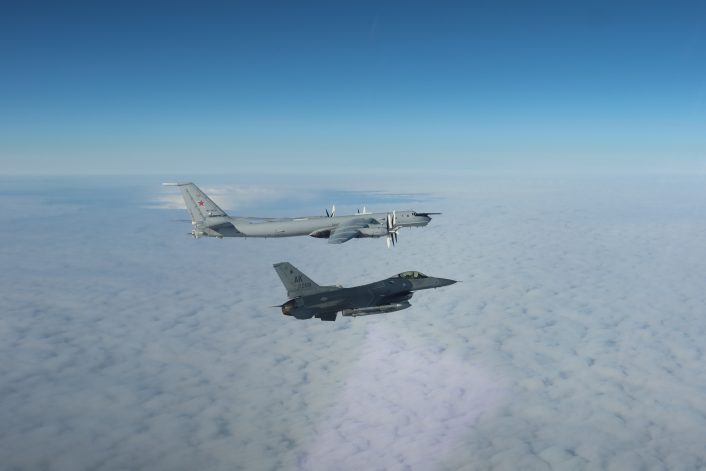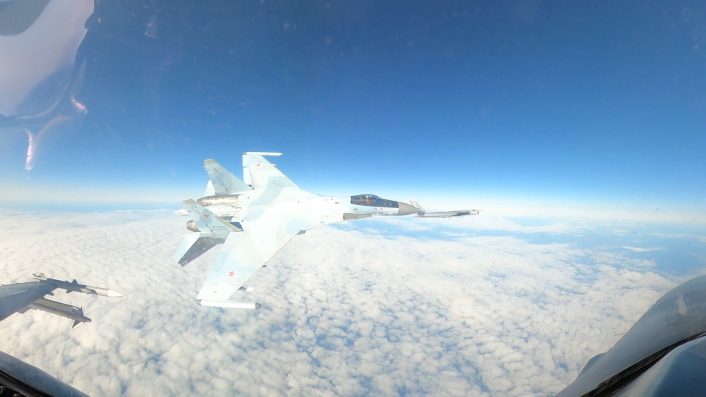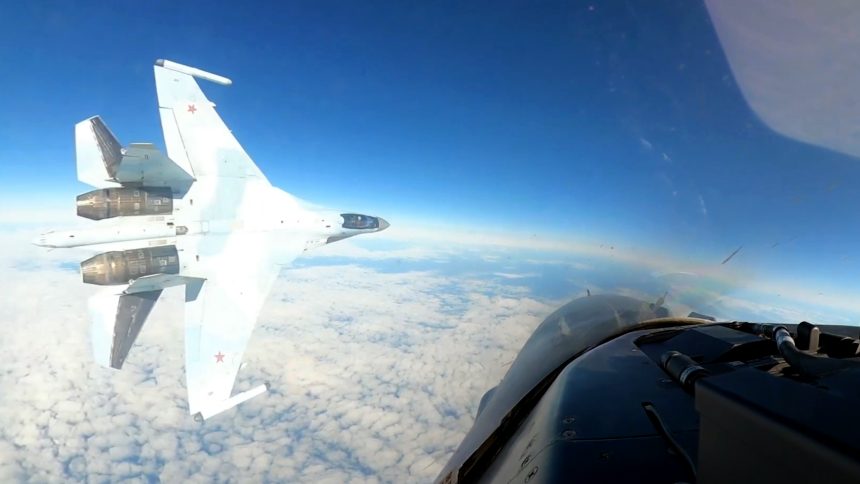The Su-35S was escorting a Russian Tu-95 off Alaska when it performed an unsafe maneuver directed at the U.S. F-16.
On September 23, 2024, the North American Aerospace Defense Command (NORAD) detected and tracked four Russian military aircraft operating in the Alaska Air Defense Identification Zone (ADIZ).
The Russian aircraft (two Tu-95 Bear bombers and two Su-35S fighters) remained in international airspace and did not enter American or Canadian sovereign airspace.
While Russian activity in the Alaska ADIZ occurs regularly and is not considered a threat, the latest interaction involved a Russian Su-35 performing a dangerous maneuver, which was filmed from the cockpit of a U.S. F-16C fighter scrambled to intercept and escort the Russian aircraft.
The video captures the moment the Russian Su-35 fighter jet executes a turn toward the F-16. The Su-35’s sleek silhouette becomes increasingly visible as it banks abruptly into the F-16, revealing its maneuver to the camera.
Gen. Gregory Guillot, Commander, NORAD and U.S. Northern Command, spoke on the event, stating: “On Monday (Sept. 23), NORAD aircraft flew a safe and disciplined intercept of Russian military aircraft in the Alaskan ADIZ. The conduct of one Russian Su-35 was unsafe, unprofessional, and endangered all – not what you’d see in a professional air force.”
NORAD had released one image from the Sept. 23, 2024 intercept inside the Alaska ADIZ, showing a 18th FIS F-16C escorting one of the Tu-95. The news and video of the aggressive maneuver by the Su-35S were not made public until Sept. 30, 2024.

Not the first time
This is not the first incident, and likely won’t be the last, where a Russian intercept has been labeled as “unprofessional” and “unsafe.” Over the years, there have been multiple reports of similar encounters, often involving U.S. Air Force MQ-9 Reaper drones, U.S. Navy P-8A Maritime Patrol and Reconnaissance Aircraft in regions like the Black Sea or off the coast of Syria. In many of these situations, Russian or Chinese fighter jets have been said to perform close, aggressive maneuvers reminiscent of stunts from Top Gun.
Until a Flanker collided with an MQ-9A Reaper over the Black Sea in 2023, in most cases, the footage released, usually shot from onboard cameras, only showed the interceptors flying in close proximity to the U.S. aircraft without any overtly dangerous actions. In fact, one former RC-135 aircraft commander, who had flown several models of the aircraft, once remarked that what is now considered “dangerous and provocative” was fairly routine for his generation of reconnaissance crews. He added that, during his time, some of these stunts were even done at the request of the intercepted aircraft.
However, this latest incident is different and remarkably similar to the one involving a Russian Su-27 flying dangerously close to the nose of a B-52 bomber over the Black Sea in 2020. In that incident, the Su-27 crossed within 100 feet of the B-52 while using afterburners, which caused significant turbulence for the larger aircraft.

While these types of stunts have yet to cause serious damage to manned aircraft, there have been concerning incidents in the past. For instance, on April 1, 2001, a U.S. Navy EP-3E aircraft was flying a surveillance mission near the island of Hainan when it was intercepted by two Chinese J-8 fighters. One of the J-8s collided with the EP-3E, breaking apart and crashing into the sea, killing the Chinese pilot. The U.S. aircraft, heavily damaged, was forced to make an emergency landing in China, where the crew was detained for 10 days.
Another incident occurred on September 13, 1987, when a Norwegian P-3B collided mid-air with a Soviet Su-27 over the Barents Sea. The collision caused severe damage to both aircraft, but they managed to return safely to their respective bases.
Given the rising tensions between NATO and Russia it’s worth considering the potential consequences if such a collision were to happen today, especially between a Russian and a U.S. aircraft. The ramifications could be severe, raising the stakes of already fragile international relations.









